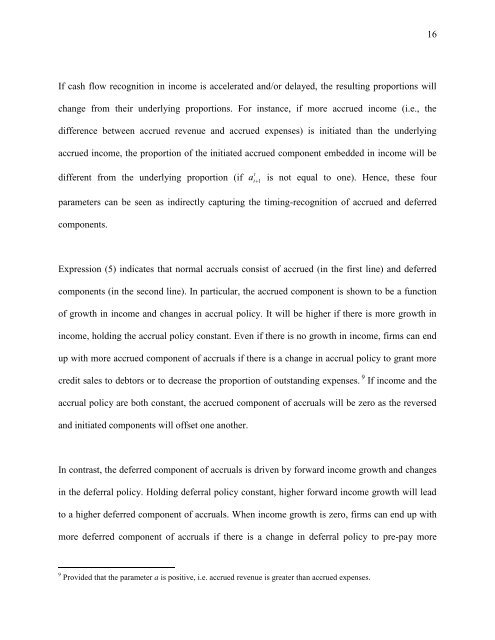Modelling the accruals process and assessing unexpected accruals*
Modelling the accruals process and assessing unexpected accruals*
Modelling the accruals process and assessing unexpected accruals*
You also want an ePaper? Increase the reach of your titles
YUMPU automatically turns print PDFs into web optimized ePapers that Google loves.
If cash flow recognition in income is accelerated <strong>and</strong>/or delayed, <strong>the</strong> resulting proportions will<br />
change from <strong>the</strong>ir underlying proportions. For instance, if more accrued income (i.e., <strong>the</strong><br />
difference between accrued revenue <strong>and</strong> accrued expenses) is initiated than <strong>the</strong> underlying<br />
accrued income, <strong>the</strong> proportion of <strong>the</strong> initiated accrued component embedded in income will be<br />
t<br />
different from <strong>the</strong> underlying proportion (if at 1 is not equal to one). Hence, <strong>the</strong>se four<br />
parameters can be seen as indirectly capturing <strong>the</strong> timing-recognition of accrued <strong>and</strong> deferred<br />
components.<br />
Expression (5) indicates that normal <strong>accruals</strong> consist of accrued (in <strong>the</strong> first line) <strong>and</strong> deferred<br />
components (in <strong>the</strong> second line). In particular, <strong>the</strong> accrued component is shown to be a function<br />
of growth in income <strong>and</strong> changes in accrual policy. It will be higher if <strong>the</strong>re is more growth in<br />
income, holding <strong>the</strong> accrual policy constant. Even if <strong>the</strong>re is no growth in income, firms can end<br />
up with more accrued component of <strong>accruals</strong> if <strong>the</strong>re is a change in accrual policy to grant more<br />
credit sales to debtors or to decrease <strong>the</strong> proportion of outst<strong>and</strong>ing expenses. 9 If income <strong>and</strong> <strong>the</strong><br />
accrual policy are both constant, <strong>the</strong> accrued component of <strong>accruals</strong> will be zero as <strong>the</strong> reversed<br />
<strong>and</strong> initiated components will offset one ano<strong>the</strong>r.<br />
In contrast, <strong>the</strong> deferred component of <strong>accruals</strong> is driven by forward income growth <strong>and</strong> changes<br />
in <strong>the</strong> deferral policy. Holding deferral policy constant, higher forward income growth will lead<br />
to a higher deferred component of <strong>accruals</strong>. When income growth is zero, firms can end up with<br />
more deferred component of <strong>accruals</strong> if <strong>the</strong>re is a change in deferral policy to pre-pay more<br />
9 Provided that <strong>the</strong> parameter a is positive, i.e. accrued revenue is greater than accrued expenses.<br />
16



